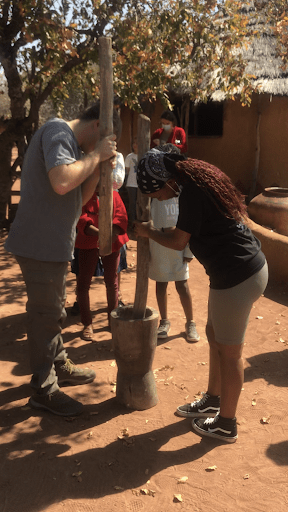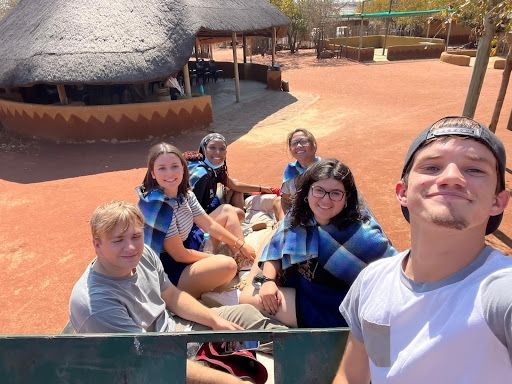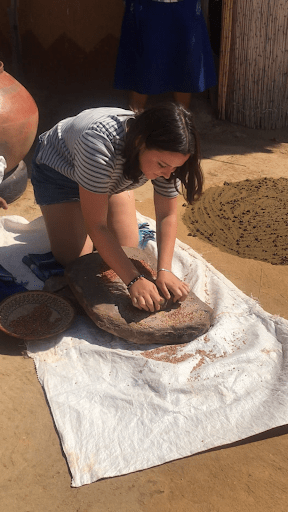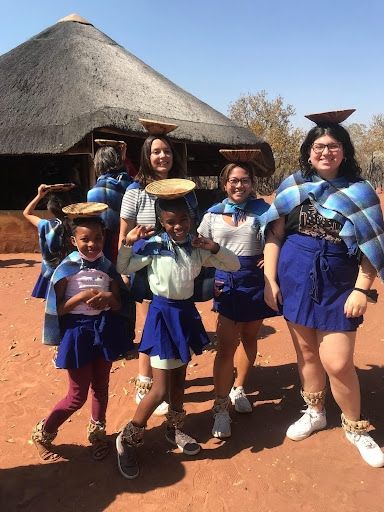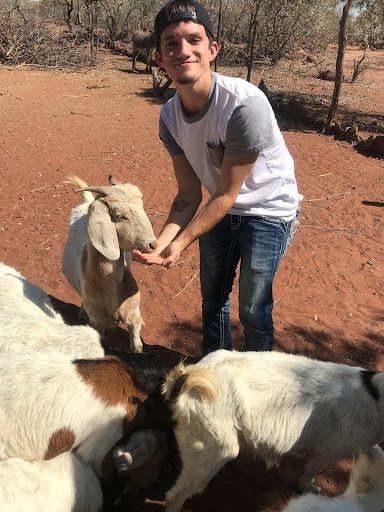Indulgence of Culture
Author: Keletso Kobedi (Student Volunteer)
The third week of the 18 week program was time to enjoy a little glimpse of setswana culture in its raw nature, and what other place would be great other than Bahurutshe Cultural Village. This is a tourist attraction in Botswana that is a recreated Hurutshe village which offers a glimpse of authentic setswana culture through crafts and dancing. It has been operating for over 20 years, and the sole purpose of Bahurutshe is the preservation of culture.
Upon arrival the students were met with ululations, which is an expression of happiness, celebration or reverence no matter how big or small the occasion.
Watch the video: Beauty of Ululating | Miss World Botswana 2021
After that beautiful entrance, and settling in, they were ushered to the shelter which in Setswana we call “Kgotla/loobo”, this is where the chief of a village holds meetings. The students were taught the proper way to dress according to tswana culture when going to the kgotla. Females are expected to wear a long dress or skirt, a shawl to cover your shoulders and a headscarf to tie your hair up and males are expected to wear long pants, a hat and a jacket.
Thereafter they headed to the traditional huts, these are houses that are built using mud and cow dung. Mud, clay soil and cow dung are mixed together to construct the huts as these were the only available materials and the cow dung specifically was used as repellent against snakes. A mud hut is a single roomed house that had several purposes, it served as a bedroom, and in another hut essentially a kitchen. For the kitchen they would construct a fire right at the center of the hut to cook using open fire. The students were shown hides from animals that would have been hunted by the men and this is what was used to sleep on.
Batswana rely heavily on farming and are mainly mixed farmers. After the plowing season ends, they thank their ancestors for a good harvest through a festival called “Dikgafela”, and the students had an opportunity to celebrate Dikgafela by having the ladies dress up in the traditional attire which is a wrap around skirt called “khiba”, and a shawl we call “tjale”. While the ladies did that, the men were seated at the Kgotla waiting to be served the harvest. The harvested crop was put Into tiny baskets that the women balanced onto their heads for a parade around the kgotla and the first harvest is given to the chief.
One of Botswana's main starch is maize meal, essentially when maize is harvested it is grinded and pounded to make it a powder called maize meal. And the students got to do that using a mortar and pestle to pound the maize. Instances where there was no mortar and pestle, a flat surfaced rock and a round stone was used to grind the maize.
To fully experience setswana farming, the students were sent to the corral (lesaka) which is usually about 500m away from the homestead using a donkey cart; this was essentially the main mode of transport, and definitely the highlight of the trip. The students got a chance to feed the goats at the corral. After that exciting corral visit the students headed back to the homestead where they were immersed into traditional song and dance.
After an impromptu lesson on how to clap and dance to traditional songs, the students were ushered to a delicacy of cultural food, which was a buffet of different traditional food consisting of pounded meat (seswaa), maize meal (pap), dumplings (madombi) mixed beans (dikgobe), yellow melon mixed with sorghum and sour milk (bogobe jwa lerotse), free range chicken, oxtail and spinach.The students licked their plates clean, a testimony of how truly delicious the food was.The students played a few traditional games such as koi'' (jump rope)and''diketo (counting game using stones). These were games played by kids as there were no toys so they had to be creative in entertaining themselves. The students appreciated a nice escape from the busy town life and retired for the day to the dorms.
The next morning , the students had an enormous breakfast and everyone said their thanks as they headed back to Gaborone, a great ending to a refreshing weekend.
Related Posts

Eat, Drink, Explore: Gaborone
BEST FOOD TO EAT IN BOTSWANA Africa is a meat-eating continent, and Botswana is no different. The country’s national meat dish has two names: “ seswaa” in the Central District... keep reading
Study Abroad in Botswana Africa
For my study abroad, I chose the Community Public Health Program in Gaborone Botswana during the Fall 2024 semester. I am a public health major on a pre-PA track and... keep reading

Internships vs. Volunteering Abroad: Which is Better?
Are you looking for internship or volunteering opportunities while abroad? You’re in luck with CIEE! Follow along as we detail the differences between internship vs. volunteer work and what you... keep reading
